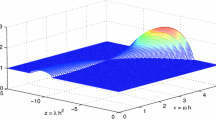Abstract
An important class of ordinary differential systems is that whose solutions satisfy a monotonicity property for a given norm. For these problems, a natural requirement for the numerical solution is the reflection of this monotonicity property, perhaps under certain stepsize restriction. For Runge–Kutta methods, when the applied norm is an arbitrary one, the stepsize restrictions depend on the radius of absolute monotonicity. However for many problems, monotonicity holds for inner product norms and therefore it makes sense to restrict the analysis to this class of norms to obtain, if possible, less restrictive results. In this paper, we consider monotonicity issues for Runge–Kutta methods when the applied norm is an inner product norm.
Similar content being viewed by others
References
Cavagna, C. (1998). Stability analysis in the numerical solution of convection-diffusion equations. Report May 2002, University of Leiden.
K. Dekker J.G. Verwer (1984) Stability of Runge–kutta methods for stiff nonlinear differential equations CWI Monographs Amsterdam
L. Ferracina M.N. Spijker (2005) ArticleTitleStepsize restrictions for the total-variation-diminishing property in general Runge–Kutta methods Math. Comp. 74 201–219 Occurrence Handle10.1090/S0025-5718-04-01664-3
S. Gottlieb Shu W. C. Tadmor E. (2001) ArticleTitleStrong stability-preserving high order time discretization methods SIAM Rev. 43 89–112 Occurrence Handle10.1137/S003614450036757X
S. Gottlieb C.W. Shu (1998) ArticleTitleTotal variation diminishing Runge–Kutta schemes Math Comp. 67 73–85
S. Gottlieb L.J. Gottlieb (2003) ArticleTitleStrong stability preserving properties of Runge–Kutta time discretization methods for linear constant coefficient operators J Sci. Comput. 18 83–109 Occurrence Handle10.1023/A:1020338228736
B. Gustafsson H.O. Kreiss J. Oliger (1995) Time Dependent Problems and Difference Methods John Willey New York
I. Higueras (2004) ArticleTitleOn strong stability preserving time discretization methods To appear in J. Sci. Comput. 21 193–223 Occurrence Handle10.1023/B:JOMP.0000030075.59237.61
D. Levy E. Tadmor (1998) ArticleTitleFrom semidiscrete to fully discrete:stability of Runge–Kutta schemes by the energy method SIAM Rev. 40 40–73 Occurrence Handle10.1137/S0036144597316255
J.F.B.M. Kraaijevanger (1991) ArticleTitleContractivity of Runge–Kutta methods BIT 31 482–528 Occurrence Handle10.1007/BF01933264
F. Riesz B. Sz-Nagy (1990) Functional Analysis Dover New York
S.J. Ruuth R.J. Spiteri (2002) ArticleTitleTwo barriers on strong stability preserving time discretization methods J. Sci. Comput. 17 211–220 Occurrence Handle10.1023/A:1015156832269 Occurrence HandleMR1910562
C.W. Shu S. Osher (1988) ArticleTitleEfficient implementation of essentially non-oscillatory shock-capturing schemes J. Comput. Phys. 77 439–471 Occurrence Handle10.1016/0021-9991(88)90177-5
Shu C.W. (2002). A survey of strong stability preserving high order time discretizations, In: D. Estep and S. Tavener, (eds) Proceedings in Applied Mathematics 109, SIAM, pp. 51–65
M.N. Spijker (1983) ArticleTitleContractivity in the numerical solution of initial value problems Numer. Math. 42 271–290 Occurrence Handle10.1007/BF01389573
M.N. Spijker (1985) ArticleTitleStepsize restrictions for stability of one-step methods in the numerical solution of initial value problems Math. Comp. 45 377–392
R.J. Spiteri S.J. Ruuth (2002) ArticleTitleA new class of optimal high order strong stability preserving time discretization methods SIAM J. Numer. Anal. 40 469–491 Occurrence Handle10.1137/S0036142901389025
Tadmor, E. (2002). From semidiscrete to fully discrete: stability of Runge-kutta schemes by the energy method II, Collected lectures on the preservation of stability under discretization. In: Estep, D. and Tavener, S (eds). Proceedings in Applied Mathematics Vol. 109, SIAM, pp. 25–49
R.P. Vander Marel (1990) ArticleTitleStability radius of polynomials occurring in the numerical solution of initial value problems BIT 30 516–528 Occurrence Handle10.1007/BF01931665
Author information
Authors and Affiliations
Corresponding author
Rights and permissions
About this article
Cite this article
Higueras, I. Monotonicity for Runge–Kutta Methods: Inner Product Norms. J Sci Comput 24, 97–117 (2005). https://doi.org/10.1007/s10915-004-4789-1
Received:
Accepted:
Issue Date:
DOI: https://doi.org/10.1007/s10915-004-4789-1




